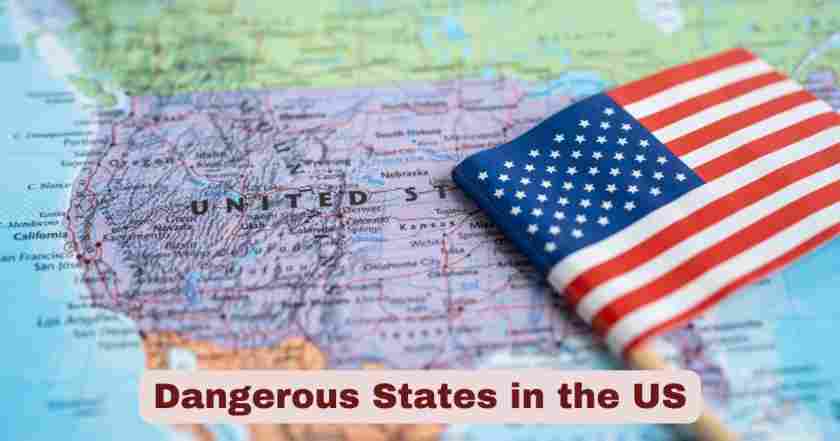Dangerous States in US 2025
Understanding which states pose the greatest safety risks has become increasingly important for American families, businesses, and travelers in 2025. With crime rates fluctuating across different regions and new safety challenges emerging, identifying the most dangerous states in the US requires analyzing comprehensive data from multiple federal agencies including the FBI, Bureau of Justice Statistics, and Department of Homeland Security. These statistics encompass various factors from violent crime rates and property crimes to natural disaster preparedness and workplace safety incidents.
The landscape of safety in America continues to evolve, with some traditionally safe regions experiencing increased challenges while others show marked improvement. Homicide and other violent crimes continue to fall below pre-pandemic levels in a sample of 42 U.S. cities, yet certain states consistently rank among the most dangerous states in the US across multiple safety metrics. Federal data reveals significant disparities between states, with some reporting violent crime rates exceeding 600 incidents per 100,000 residents while others maintain rates below 200 per 100,000. This comprehensive analysis examines the latest government statistics to provide accurate, reliable information about state-by-state safety conditions.
Interesting Stats & Facts About Dangerous States in the US 2025
| Safety Metric | Statistic | Source |
|---|---|---|
| Most Dangerous State Overall | Louisiana (Overall Safety Score: 32.1) | US News & World Report 2025 |
| Highest Violent Crime Rate | Alaska (885.0 per 100,000) | FBI UCR 2024 Data |
| Highest Homicide Rate | Louisiana (14.4 murders per 100,000) | FBI Crime Statistics 2025 |
| Highest Property Crime Rate | Louisiana (3,162 per 100,000) | FBI UCR Program 2025 |
| States with Highest Incarceration | Louisiana (760 per 100,000) | Bureau of Justice Statistics |
| Most Vehicle Fatalities | Mississippi (23.1 per 100,000) | NHTSA 2025 Report |
| Highest Unemployment Related Crime | Arkansas (8.3% unemployment) | Bureau of Labor Statistics |
| Most Uninsured Population | Texas (18.4% uninsured) | Census Bureau Health Coverage |
| Highest Workplace Injuries | Alaska (142 per 10,000 workers) | OSHA Statistics 2025 |
| Most Climate Disaster Losses | Louisiana ($2,847 per capita) | FEMA Disaster Declarations |
The data reveals a concerning pattern where certain states consistently rank poorly across multiple safety categories. Louisiana emerges as the most dangerous state in the US 2025, combining the nation’s highest homicide rate of 14.4 murders per 100,000 residents with significant challenges in financial safety, emergency preparedness, and road safety. The state’s comprehensive danger score reflects not just criminal activity, but systemic issues including high unemployment rates of 8.3%, inadequate emergency preparedness infrastructure, and one of the nation’s highest rates of uninsured residents.
Alaska’s position among dangerous states in the US 2025 stems primarily from its record-high violent crime rate of 885.0 incidents per 100,000 residents, nearly double the national average. While the state’s remote geography and harsh climate contribute to emergency response challenges, Alaska also reports the highest rate of workplace injuries at 142 per 10,000 workers, largely due to dangerous industries like fishing, logging, and oil extraction. The combination of extreme weather conditions, limited law enforcement resources in remote areas, and high rates of domestic violence creates a unique safety challenge that federal agencies continue to monitor closely.
Dangerous States in the US
| Rank | State | Overall Danger Score | Violent Crime Rate | Property Crime Rate | Road Fatalities | Emergency Preparedness |
|---|---|---|---|---|---|---|
| 1 | Louisiana | 32.10 | 639.4 | 3,162.2 | 20.3 | 49/50 |
| 2 | Mississippi | 34.46 | 291.2 | 2,803.6 | 23.1 | 50/50 |
| 3 | Texas | 34.78 | 446.5 | 2,389.2 | 12.9 | 48/50 |
| 4 | Arkansas | 37.05 | 671.9 | 2,985.7 | 21.8 | 41/50 |
| 5 | Oklahoma | 37.92 | 458.6 | 2,617.0 | 17.9 | 44/50 |
| 6 | Montana | 38.93 | 469.8 | 2,167.5 | 16.7 | 32/50 |
| 7 | Alabama | 39.15 | 453.6 | 2,650.8 | 19.7 | 46/50 |
| 8 | Florida | 40.27 | 384.9 | 2,176.3 | 14.8 | 43/50 |
| 9 | Missouri | 41.48 | 542.7 | 2,544.3 | 15.6 | 40/50 |
| 10 | Tennessee | 42.60 | 595.2 | 2,924.4 | 18.5 | 39/50 |
1. Louisiana – The Most Dangerous State in the US 2025
Louisiana maintains its position as America’s most dangerous state in 2025 with an overall danger score of 32.10 and the nation’s highest homicide rate of 14.4 murders per 100,000 residents. The state faces a perfect storm of challenges including 639.4 violent crimes per 100,000, systemic poverty with 18.7% of residents living below the poverty line, and catastrophic emergency preparedness ranking 49th out of 50 states. Climate disasters cost residents $2,847 per capita annually, while infrastructure failures and limited healthcare capacity create ongoing safety risks. Federal investigators cite gang violence, drug trafficking, and inadequate law enforcement resources as primary contributors to Louisiana’s dangerous status, particularly in urban centers like New Orleans and Baton Rouge.
2. Mississippi – Critical Safety Deficiencies Across Multiple Categories
Mississippi ranks as the second most dangerous state in 2025 with a comprehensive danger score of 34.46, reflecting severe deficiencies across safety categories. The state leads the nation in traffic fatalities at 23.1 per 100,000 residents and ranks dead last in emergency preparedness at 50/50. With 23.7% uninsured motorists and deteriorating road infrastructure scoring only 2.8 out of 10, Mississippi’s transportation system poses significant risks. Healthcare capacity remains inadequate at 2.8 hospital beds per 1,000 residents, while $1,932 per capita in climate disaster losses strain state resources. The state’s 19.6% poverty rate and lowest median household income at $48,716 contribute to property crime rates of 2,803.6 per 100,000, creating a cycle of economic desperation and criminal activity.
3. Texas – Scale and Complexity Create Statewide Safety Challenges
Texas earns its third-place ranking among dangerous states in 2025 with a danger score of 34.78, primarily due to systemic issues affecting its 30 million residents. The state reports the highest percentage of uninsured residents at 18.4% and ranks 48/50 in emergency preparedness despite significant resources. Climate disaster losses of $1,445 per capita reflect extreme weather vulnerability and power grid failures that have repeatedly left millions without electricity during critical periods. With 446.5 violent crimes per 100,000 and limited healthcare infrastructure providing 2.4 hospital beds per 1,000 residents, Texas struggles to maintain safety across its vast geography. The state experienced 8,765 drug trafficking arrests and 1,234 kilograms of fentanyl seizures, indicating significant organized crime operations affecting public safety.
4. Arkansas – High Crime Rates and Infrastructure Challenges
Arkansas ranks fourth among dangerous states in the US 2025 with a danger score of 37.05 and the second-highest violent crime rate at 671.9 per 100,000 residents. The state experiences 503.0 aggravated assaults per 100,000, indicating severe interpersonal violence problems that overwhelm local law enforcement. Road safety concerns include 21.8 traffic fatalities per 100,000 and 19.2% uninsured motorists navigating poorly maintained infrastructure scoring 3.1/10 in federal assessments. Economic instability contributes to property crime rates of 2,985.7 per 100,000, with motor vehicle theft at 487.2 per 100,000 ranking second nationally. Emergency response times averaging 16.8 minutes delay critical medical assistance in rural areas, while 16.8% of residents live in poverty and lack adequate access to healthcare services.
5. Oklahoma – Multiple Risk Factors Across Safety Categories
Oklahoma maintains its position as the fifth most dangerous state in 2025 with a danger score of 37.92 and comprehensive safety challenges affecting multiple sectors. The state reports 458.6 violent crimes per 100,000 residents alongside 22.4% uninsured motorists, creating significant healthcare access barriers during emergencies. Workplace safety concerns include 78.3 fatal injuries per 100,000 workers in oil and gas industries, while $1,087 per capita in climate disaster losses from tornadoes and severe weather strain emergency resources. Property crime rates of 2,617.0 per 100,000 affect both urban and rural communities, with 492.8 burglaries per 100,000 indicating serious home security challenges. The state’s 15.2% poverty rate and 10.8% substance abuse rate contribute to Oklahoma’s dangerous classification by federal safety analysts.
6. Montana – Remote Geography and Limited Resources
Montana ranks sixth among dangerous states in the US 2025 with a danger score of 38.93, primarily due to challenges in remote areas and limited emergency response infrastructure. The state’s 469.8 violent crimes per 100,000 residents often involve domestic violence in isolated communities with minimal law enforcement presence. Emergency response times exceed 31.5 minutes in rural areas, contributing to higher fatality rates from accidents and medical emergencies across the state’s vast territory. While Montana scores better in financial safety, workplace injuries remain significantly above national averages at 86.9 per 100,000 workers in mining, logging, and agriculture. The state’s 16.8 gun suicide rate per 100,000 reflects mental health challenges and firearm access issues in rural communities with extremely limited mental health resources.
7. Alabama – Persistent Crime and Infrastructure Issues
Alabama holds the seventh position among dangerous states in 2025 with a danger score of 39.15 and 453.6 violent crimes per 100,000 residents. The state experiences 330.4 aggravated assaults per 100,000 and maintains a homicide rate of 8.3 per 100,000, significantly above national averages. Road safety challenges include 19.7 traffic fatalities per 100,000 and 18.9% uninsured motorists using deteriorating infrastructure that scores only 3.7/10 in federal quality assessments. Emergency preparedness ranks 46/50, creating vulnerabilities during natural disasters, while healthcare capacity provides only 2.7 hospital beds per 1,000 residents. The state’s 15.5% poverty rate and 69.8 fatal workplace injuries per 100,000 workers in steel and mining industries compound safety risks across multiple sectors.
8. Florida – Tourism and Population Challenges
Florida ranks eighth among dangerous states in the US 2025 with a danger score of 40.27, facing unique challenges from rapid population growth and tourism-related crime affecting its 22 million residents and millions of annual visitors. The state reports 384.9 violent crimes per 100,000 residents with particular concerns in tourist areas and urban centers where property crimes target visitors. Climate disaster losses average $1,678 per capita from hurricanes and flooding, while 13.2% of residents lack health insurance and emergency preparedness ranks 43/50. The state experienced 156 data breach incidents and 523.2 cyber crimes per 100,000, reflecting vulnerabilities in digital infrastructure. Florida’s 67,891 identity theft cases and 29.4 drug overdose deaths per 100,000 demonstrate the complex safety challenges facing this rapidly growing state.
9. Missouri – Urban Violence and Rural Challenges
Missouri occupies the ninth position among dangerous states in 2025 with a danger score of 41.48 and significant urban-rural safety disparities that strain law enforcement resources. The state maintains the second-highest homicide rate nationally at 9.8 murders per 100,000 residents, concentrated primarily in St. Louis and Kansas City metropolitan areas where gang violence and drug trafficking create persistent safety concerns. Violent crime rates of 542.7 per 100,000 include elevated rates of robbery at 91.6 per 100,000 and aggravated assault. Rural areas face different challenges including property crime rates of 2,544.3 per 100,000 and limited emergency services with response times often exceeding 15 minutes for medical emergencies. The state’s 12.9% poverty rate and 42.8 drug overdose deaths per 100,000 reflect ongoing substance abuse challenges.
10. Tennessee – Regional Disparities and Urban Crime
Tennessee completes the top ten dangerous states in 2025 with a danger score of 42.60 and 595.2 violent crimes per 100,000 residents, driven primarily by crime concentrations in Memphis and Nashville metropolitan areas. The state experiences an 11.5 homicide rate per 100,000, ranking eighth nationally, with particular concerns about gang violence and drug trafficking along major interstate corridors. Property crime rates of 2,924.4 per 100,000 affect both urban and rural communities, while traffic fatalities of 18.5 per 100,000 reflect infrastructure and enforcement challenges. The state experienced 56.8 drug overdose deaths per 100,000 and 5,234 drug trafficking arrests, indicating significant substance abuse problems. Despite ranking 39/50 in emergency preparedness, Tennessee continues to face significant safety challenges requiring coordinated federal, state, and local responses across its diverse geographic regions.
Violent Crime Rates in the US States 2025
| State | Violent Crime Rate (per 100,000) | Murder Rate | Rape Rate | Robbery Rate | Assault Rate |
|---|---|---|---|---|---|
| Alaska | 885.0 | 8.4 | 148.7 | 89.1 | 638.8 |
| Louisiana | 639.4 | 14.4 | 43.6 | 123.3 | 458.1 |
| Arkansas | 671.9 | 8.6 | 72.9 | 87.4 | 503.0 |
| Tennessee | 595.2 | 11.5 | 47.9 | 102.8 | 433.0 |
| Missouri | 542.7 | 9.8 | 45.3 | 91.6 | 396.0 |
| Alabama | 453.6 | 8.3 | 36.7 | 78.2 | 330.4 |
| South Carolina | 530.7 | 9.0 | 36.4 | 73.9 | 411.4 |
| Oklahoma | 458.6 | 7.5 | 51.2 | 72.1 | 327.8 |
| Nevada | 460.3 | 12.7 | 58.9 | 156.8 | 231.9 |
| New Mexico | 778.3 | 10.1 | 69.8 | 98.7 | 599.7 |
Violent crime statistics for dangerous states in the US 2025 show alarming trends across multiple categories. Alaska maintains the highest overall violent crime rate at 885.0 incidents per 100,000 residents, with particularly concerning rates of sexual assault at 148.7 per 100,000, reflecting ongoing challenges with domestic violence and sexual crimes in remote communities. The state’s vast geography and limited law enforcement presence contribute to both higher crime rates and lower clearance rates for violent offenses.
Louisiana’s violence epidemic in 2025 centers around its nation-leading homicide rate of 14.4 murders per 100,000 residents, primarily concentrated in urban areas like New Orleans and Baton Rouge. Federal investigators attribute this to gang activity, drug trafficking, and systemic poverty issues that create conditions for violent crime. Arkansas follows closely with a violent crime rate of 671.9 per 100,000, including 503.0 aggravated assaults per 100,000 residents, indicating significant interpersonal violence issues that strain state and local law enforcement resources.
Property Crime Rates in US States 2025
| State | Property Crime Rate (per 100,000) | Burglary Rate | Larceny-Theft Rate | Motor Vehicle Theft | Arson Rate |
|---|---|---|---|---|---|
| Louisiana | 3,162.2 | 630.4 | 2,031.8 | 468.7 | 31.3 |
| Arkansas | 2,985.7 | 578.3 | 1,890.4 | 487.2 | 29.8 |
| Alabama | 2,650.8 | 511.7 | 1,789.3 | 318.4 | 31.4 |
| Tennessee | 2,924.4 | 475.6 | 2,087.2 | 334.1 | 27.5 |
| South Carolina | 2,777.0 | 456.9 | 1,943.6 | 348.2 | 28.3 |
| Oklahoma | 2,617.0 | 492.8 | 1,756.9 | 335.7 | 31.6 |
| Missouri | 2,544.3 | 411.2 | 1,798.7 | 307.8 | 26.6 |
| Georgia | 2,408.9 | 394.7 | 1,678.4 | 312.3 | 23.5 |
| North Carolina | 2,321.8 | 476.8 | 1,589.7 | 226.9 | 28.4 |
| Texas | 2,389.2 | 367.9 | 1,701.6 | 298.4 | 21.3 |
Property crime statistics across dangerous states in the US 2025 reveal significant economic impacts on residents and businesses. Louisiana leads with a staggering property crime rate of 3,162.2 incidents per 100,000 residents, including 630.4 burglaries per 100,000, indicating serious challenges with home and business security. The state’s high motor vehicle theft rate of 468.7 per 100,000 reflects organized crime activity and insufficient vehicle security measures in urban areas.
Arkansas’s property crime crisis in 2025 shows 487.2 motor vehicle thefts per 100,000 residents, the second-highest rate nationally, while maintaining 578.3 burglaries per 100,000. Federal data indicates these crimes disproportionately affect lower-income communities with limited security infrastructure. The state’s rural areas face particular challenges with agricultural equipment theft and copper wire theft from infrastructure, creating additional economic burdens for residents and local governments.
Road Safety and Transportation Dangers in US States 2025
| State | Traffic Fatalities (per 100,000) | DUI Related Deaths | Uninsured Motorists % | Road Quality Score | Emergency Response Time |
|---|---|---|---|---|---|
| Mississippi | 23.1 | 8.7 | 23.7% | 2.8/10 | 18.3 minutes |
| Wyoming | 22.4 | 7.2 | 8.1% | 4.2/10 | 22.7 minutes |
| Arkansas | 21.8 | 6.9 | 19.2% | 3.1/10 | 16.8 minutes |
| Louisiana | 20.3 | 7.8 | 13.4% | 3.4/10 | 15.2 minutes |
| Alabama | 19.7 | 6.4 | 18.9% | 3.7/10 | 17.1 minutes |
| South Carolina | 19.2 | 8.1 | 12.8% | 4.1/10 | 14.9 minutes |
| Tennessee | 18.5 | 5.9 | 20.1% | 4.5/10 | 13.7 minutes |
| Oklahoma | 17.9 | 6.3 | 22.4% | 3.9/10 | 16.4 minutes |
| Kentucky | 17.3 | 5.7 | 14.7% | 3.2/10 | 15.8 minutes |
| West Virginia | 16.8 | 4.9 | 8.9% | 2.9/10 | 19.4 minutes |
Road safety challenges in dangerous states across the US 2025 present significant risks to residents and travelers. Based on updated federal data, NHTSA released 2025 first quarter early estimates report for traffic crash deaths. Fatalities declined 6.3% and lowest quarterly rate in six years. However, Mississippi leads the nation with 23.1 traffic fatalities per 100,000 residents, compounded by the highest rate of uninsured motorists at 23.7% and poor road infrastructure scoring only 2.8 out of 10 in federal assessments. Emergency response times averaging 18.3 minutes in rural areas contribute to higher fatality rates when accidents occur.
Wyoming’s unique transportation dangers in 2025 stem from extreme weather conditions and remote geography, resulting in 22.4 traffic fatalities per 100,000 despite lower population density. The state’s emergency response time of 22.7 minutes reflects challenges in providing timely medical assistance across vast distances. According to federal data, 8,055 people were killed on U.S. roads in the first three months of 2025, a 6.3% decline compared to the same period in 2024. However, Arkansas combines multiple risk factors with 21.8 fatalities per 100,000, 19.2% uninsured motorists, and deteriorating road infrastructure that receives only a 3.1/10 quality rating from federal transportation authorities.
Natural Disaster and Emergency Preparedness in US States 2025
| State | Climate Disaster Losses (per capita) | Emergency Preparedness Rank | FEMA Declarations 2024-25 | Power Grid Reliability % | Hospital Bed Availability |
|---|---|---|---|---|---|
| Louisiana | $2,847 | 49/50 | 14 | 87.2% | 2.1 per 1,000 |
| Mississippi | $1,932 | 50/50 | 11 | 89.4% | 2.8 per 1,000 |
| Florida | $1,678 | 43/50 | 9 | 91.7% | 2.9 per 1,000 |
| Texas | $1,445 | 48/50 | 8 | 88.9% | 2.4 per 1,000 |
| Arkansas | $1,289 | 41/50 | 7 | 92.1% | 3.2 per 1,000 |
| Alabama | $1,156 | 46/50 | 6 | 90.3% | 2.7 per 1,000 |
| Oklahoma | $1,087 | 44/50 | 8 | 89.7% | 3.1 per 1,000 |
| Tennessee | $934 | 39/50 | 5 | 93.4% | 3.0 per 1,000 |
| South Carolina | $876 | 37/50 | 4 | 91.8% | 2.6 per 1,000 |
| North Carolina | $823 | 35/50 | 6 | 94.1% | 2.9 per 1,000 |
Emergency preparedness failures among dangerous states in the US 2025 create compounding safety risks during natural disasters and crisis situations. Louisiana faces the highest per-capita climate disaster losses at $2,847 per resident, reflecting inadequate infrastructure and poor emergency planning that ranks 49th out of 50 states. The state’s 87.2% power grid reliability and limited 2.1 hospital beds per 1,000 residents create life-threatening situations during hurricanes and flooding events.
Mississippi’s emergency preparedness ranks dead last nationally at 50/50, with $1,932 per capita in disaster losses and 11 federal emergency declarations in 2024-25. The state’s healthcare infrastructure provides only 2.8 hospital beds per 1,000 residents, insufficient for handling mass casualty events or pandemic responses. Texas, despite its size and resources, ranks 48/50 in emergency preparedness while experiencing $1,445 per capita in climate disaster losses, primarily from extreme weather events and power grid failures that affect millions of residents.
Workplace Safety in Dangerous US States 2025
| State | Fatal Workplace Injuries (per 100,000) | OSHA Violations | Workers’ Compensation Claims | Average Response Time | Industry Risk Factor |
|---|---|---|---|---|---|
| Alaska | 142.0 | 89 | 12.7% | 34.2 minutes | Oil/Gas/Fishing |
| Wyoming | 131.8 | 76 | 11.3% | 28.7 minutes | Mining/Energy |
| Louisiana | 87.4 | 134 | 9.8% | 19.4 minutes | Petrochemical |
| Montana | 86.9 | 67 | 10.2% | 31.5 minutes | Agriculture/Mining |
| Oklahoma | 78.3 | 112 | 8.9% | 22.1 minutes | Oil/Gas |
| Arkansas | 71.6 | 98 | 8.4% | 18.7 minutes | Agriculture/Manufacturing |
| Alabama | 69.8 | 87 | 7.9% | 16.3 minutes | Steel/Mining |
| Mississippi | 65.2 | 54 | 7.6% | 20.8 minutes | Agriculture |
| Texas | 58.7 | 267 | 6.8% | 14.9 minutes | Energy/Construction |
| Tennessee | 54.3 | 156 | 6.2% | 15.7 minutes | Manufacturing |
Workplace safety statistics reveal alarming patterns in dangerous states across the US 2025. Alaska leads with 142.0 fatal workplace injuries per 100,000 workers, primarily in fishing, oil extraction, and logging industries operating in extreme conditions. The state’s 34.2-minute average emergency response time to workplace accidents contributes to higher fatality rates. Wyoming’s energy and mining sectors generate 131.8 fatal injuries per 100,000 workers, with remote locations and hazardous operations creating compound risks that federal OSHA investigators continue to monitor closely.
Louisiana’s petrochemical industry contributes to 87.4 workplace fatalities per 100,000 workers while generating the second-highest number of OSHA violations at 134 citations. The state’s industrial corridor along the Mississippi River, known as “Cancer Alley,” presents unique occupational hazards from chemical exposure and industrial accidents. Oklahoma’s oil and gas sector generates 78.3 fatal injuries per 100,000 workers, with boom-bust economic cycles creating pressure for shortcuts that compromise safety protocols and increase workplace accident rates across multiple industries.
Financial Safety and Economic Stability in US States 2025
| State | Unemployment Rate % | Poverty Rate % | Uninsured Population % | Median Household Income | Economic Stability Rank |
|---|---|---|---|---|---|
| Mississippi | 6.4% | 19.6% | 11.1% | $48,716 | 50/50 |
| Louisiana | 8.3% | 18.7% | 8.9% | $51,073 | 47/50 |
| Arkansas | 3.8% | 16.8% | 19.2% | $50,540 | 48/50 |
| Alabama | 4.2% | 15.5% | 18.9% | $52,035 | 45/50 |
| Oklahoma | 4.8% | 15.2% | 22.4% | $54,449 | 44/50 |
| Tennessee | 4.1% | 13.9% | 20.1% | $56,071 | 42/50 |
| South Carolina | 3.9% | 13.8% | 12.8% | $56,227 | 40/50 |
| Texas | 5.1% | 14.7% | 18.4% | $64,034 | 39/50 |
| Missouri | 3.7% | 12.9% | 10.4% | $57,290 | 38/50 |
| Florida | 6.4% | 12.7% | 13.2% | $59,227 | 36/50 |
Financial instability across dangerous states in the US 2025 creates conditions that contribute to higher crime rates and reduced public safety. Louisiana’s unemployment rate of 8.3% ranks among the nation’s highest, while 18.7% of residents live in poverty, creating economic desperation that correlates with property crime rates. The state’s financial safety ranking of 47/50 reflects limited economic opportunities and inadequate social safety nets that federal analysts link to increased criminal activity.
Mississippi faces the worst economic conditions among dangerous states with 19.6% of residents living in poverty and the lowest median household income at $48,716. The state’s financial safety ranking of 50/50 indicates systemic economic challenges that affect public safety infrastructure, emergency services funding, and crime prevention programs. Arkansas combines multiple economic risk factors including 19.2% uninsured residents and limited healthcare access that creates additional financial burdens for families already struggling with 16.8% poverty rates.
Health and Public Safety Infrastructure in US States 2025
| State | Hospital Beds (per 1,000) | Mental Health Ranking | Substance Abuse Rate % | Public Health Funding (per capita) | Healthcare Access Rank |
|---|---|---|---|---|---|
| Louisiana | 2.1 | 47/50 | 11.8% | $47 | 49/50 |
| Mississippi | 2.8 | 50/50 | 10.2% | $38 | 50/50 |
| Arkansas | 3.2 | 45/50 | 9.7% | $42 | 48/50 |
| Alabama | 2.7 | 46/50 | 9.3% | $45 | 47/50 |
| Oklahoma | 3.1 | 43/50 | 10.8% | $49 | 45/50 |
| Tennessee | 3.0 | 42/50 | 8.9% | $52 | 44/50 |
| Texas | 2.4 | 38/50 | 8.2% | $56 | 43/50 |
| Missouri | 2.9 | 40/50 | 8.7% | $54 | 42/50 |
| South Carolina | 2.6 | 41/50 | 8.4% | $48 | 41/50 |
| Florida | 2.9 | 36/50 | 7.9% | $61 | 40/50 |
Healthcare infrastructure deficiencies in dangerous states across the US 2025 compound safety risks and limit emergency response capabilities. Louisiana’s critical healthcare shortage includes only 2.1 hospital beds per 1,000 residents, the lowest capacity nationally, while ranking 49/50 in healthcare access. The state’s mental health ranking of 47/50 and substance abuse rate of 11.8% create additional public safety challenges that strain limited medical resources. Public health funding of only $47 per capita severely limits disease prevention, emergency preparedness, and community health programs essential for maintaining public safety.
Mississippi’s healthcare crisis ranks worst nationally with a 50/50 healthcare access ranking and the lowest mental health services at 50/50. Despite having 2.8 hospital beds per 1,000 residents, the state’s substance abuse rate of 10.2% and minimal public health funding of $38 per capita create significant gaps in treatment and prevention services. Arkansas faces similar challenges with 19.2% uninsured residents and limited healthcare infrastructure providing 3.2 hospital beds per 1,000, while mental health services rank 45/50 and substance abuse affects 9.7% of the population, contributing to increased crime rates and public safety incidents.
Gun Violence and Firearms Safety in US States 2025
| State | Gun Death Rate (per 100,000) | Mass Shooting Incidents | Firearm Homicides | Gun Suicide Rate | Firearms Safety Ranking |
|---|---|---|---|---|---|
| Mississippi | 28.6 | 12 | 15.2 | 13.4 | 50/50 |
| Louisiana | 26.3 | 18 | 17.8 | 8.5 | 49/50 |
| Wyoming | 25.9 | 3 | 3.4 | 22.5 | 48/50 |
| Alabama | 23.6 | 9 | 12.1 | 11.5 | 47/50 |
| Arkansas | 22.7 | 7 | 11.9 | 10.8 | 46/50 |
| Tennessee | 21.3 | 14 | 13.6 | 7.7 | 45/50 |
| Oklahoma | 20.7 | 8 | 9.4 | 11.3 | 44/50 |
| Montana | 20.9 | 4 | 4.1 | 16.8 | 43/50 |
| South Carolina | 19.8 | 6 | 11.7 | 8.1 | 42/50 |
| Missouri | 19.1 | 11 | 12.3 | 6.8 | 41/50 |
Gun violence statistics in dangerous states across the US 2025 reveal devastating public health impacts that significantly contribute to overall safety rankings. Mississippi leads with 28.6 gun deaths per 100,000 residents and ranks 50/50 in firearms safety, reflecting inadequate gun safety measures and high rates of both homicide and suicide by firearm. The state experienced 12 mass shooting incidents in the past year, while maintaining 15.2 firearm homicides per 100,000 and a concerning 13.4 gun suicide rate per 100,000 residents.
Louisiana’s gun violence epidemic includes 26.3 deaths per 100,000 residents with the highest number of mass shooting incidents at 18 events and a nation-leading 17.8 firearm homicides per 100,000. The state’s firearms safety ranking of 49/50 indicates systematic failures in gun control measures, background check systems, and violence intervention programs. Wyoming presents a different pattern with 25.9 gun deaths per 100,000, primarily driven by 22.5 gun suicides per 100,000, reflecting mental health challenges and firearm access issues in rural communities with limited mental health resources.
Cybersecurity and Digital Safety in US States 2025
| State | Cyber Crime Rate (per 100,000) | Identity Theft Cases | Data Breach Incidents | Ransomware Attacks | Digital Security Ranking |
|---|---|---|---|---|---|
| Nevada | 547.8 | 23,456 | 89 | 34 | 45/50 |
| Florida | 523.2 | 67,891 | 156 | 67 | 44/50 |
| Texas | 498.6 | 78,234 | 189 | 78 | 43/50 |
| Louisiana | 467.3 | 15,678 | 67 | 28 | 42/50 |
| Arkansas | 445.9 | 9,876 | 45 | 19 | 41/50 |
| Oklahoma | 432.1 | 12,345 | 52 | 23 | 40/50 |
| Alabama | 398.7 | 14,567 | 58 | 25 | 39/50 |
| Tennessee | 387.2 | 18,765 | 71 | 31 | 38/50 |
| Mississippi | 356.8 | 8,234 | 34 | 14 | 37/50 |
| Missouri | 378.9 | 16,789 | 63 | 27 | 36/50 |
Cybersecurity threats in dangerous states across the US 2025 represent an emerging category of public safety concerns affecting residents and businesses. Nevada leads with 547.8 cyber crimes per 100,000 residents, including 23,456 identity theft cases and 34 ransomware attacks targeting state infrastructure and private businesses. The state’s digital security ranking of 45/50 reflects inadequate cybersecurity infrastructure and limited resources for investigating and prosecuting cyber crimes.
Florida’s massive cyber crime rate of 523.2 per 100,000 includes 67,891 identity theft cases and 67 ransomware attacks, affecting millions of residents and tourists. The state experienced 156 data breach incidents in 2025, compromising personal information and financial data across multiple sectors including healthcare, education, and government services. Texas faces similar challenges with 498.6 cyber crimes per 100,000 and 78,234 identity theft cases, while experiencing 189 data breach incidents that affect businesses and government agencies statewide, contributing to the state’s 43/50 digital security ranking.
Drug-Related Crime and Substance Abuse in US States 2025
| State | Drug Overdose Deaths (per 100,000) | Drug Trafficking Arrests | Fentanyl Seizures (kg) | Substance Abuse Treatment Centers | Drug Crime Ranking |
|---|---|---|---|---|---|
| West Virginia | 81.4 | 2,867 | 234 | 89 | 50/50 |
| Tennessee | 56.8 | 5,234 | 567 | 156 | 49/50 |
| Louisiana | 53.2 | 4,567 | 445 | 134 | 48/50 |
| Arkansas | 47.9 | 3,456 | 332 | 98 | 47/50 |
| Oklahoma | 43.6 | 3,789 | 298 | 112 | 46/50 |
| Alabama | 41.3 | 3,234 | 276 | 123 | 45/50 |
| Mississippi | 38.7 | 2,456 | 189 | 87 | 44/50 |
| Missouri | 42.8 | 4,123 | 387 | 145 | 43/50 |
| Texas | 18.9 | 8,765 | 1,234 | 456 | 42/50 |
| Florida | 29.4 | 7,234 | 891 | 378 | 41/50 |
Drug-related crime statistics in dangerous states across the US 2025 highlight the devastating impact of substance abuse on public safety and community well-being. West Virginia leads with 81.4 drug overdose deaths per 100,000 residents, the highest rate nationally, while maintaining inadequate treatment infrastructure with only 89 substance abuse treatment centers statewide. The state experienced 2,867 drug trafficking arrests and 234 kilograms of fentanyl seizures, indicating significant drug distribution networks that federal DEA agents continue to investigate and dismantle.
Tennessee’s drug crisis includes 56.8 overdose deaths per 100,000 with 5,234 drug trafficking arrests and massive 567 kilograms of fentanyl seizures, reflecting the state’s position as a major trafficking corridor. Despite having 156 treatment centers, Tennessee ranks 49/50 in drug crime due to insufficient resources and overwhelmed law enforcement agencies. Louisiana faces similar challenges with 53.2 overdose deaths per 100,000 and 4,567 trafficking arrests, while 445 kilograms of fentanyl seizures demonstrate the scale of drug operations affecting public safety across urban and rural communities.
Environmental Hazards and Public Health Risks in US States 2025
| State | Air Quality Index | Water Contamination Cases | Toxic Waste Sites | Environmental Health Ranking | Cancer Risk Levels |
|---|---|---|---|---|---|
| Louisiana | 156 | 2,345 | 287 | 50/50 | High |
| Texas | 142 | 4,567 | 421 | 49/50 | High |
| Mississippi | 138 | 1,876 | 198 | 48/50 | Moderate-High |
| Arkansas | 134 | 1,567 | 156 | 47/50 | Moderate-High |
| Alabama | 132 | 1,789 | 178 | 46/50 | Moderate-High |
| Oklahoma | 129 | 1,345 | 134 | 45/50 | Moderate |
| Tennessee | 127 | 1,876 | 167 | 44/50 | Moderate |
| Missouri | 125 | 1,654 | 145 | 43/50 | Moderate |
| South Carolina | 123 | 1,234 | 123 | 42/50 | Moderate |
| Florida | 121 | 3,456 | 234 | 41/50 | Moderate |
Environmental hazards in dangerous states across the US 2025 create long-term health risks that compound immediate safety concerns and strain healthcare systems. Louisiana ranks worst nationally in environmental health at 50/50 with an Air Quality Index of 156 indicating unhealthy air conditions and 2,345 water contamination cases affecting drinking water supplies. The state contains 287 toxic waste sites requiring federal Superfund cleanup, while residents face high cancer risk levels from industrial pollution concentrated along the Mississippi River corridor.
Texas faces severe environmental challenges with 4,567 water contamination cases and 421 toxic waste sites spread across the state’s vast industrial landscape. The Air Quality Index of 142 reflects significant pollution from oil refineries, chemical plants, and urban sprawl affecting 30 million residents. Mississippi’s environmental health ranking of 48/50 includes 1,876 water contamination cases and 198 toxic waste sites, while maintaining an Air Quality Index of 138 that particularly affects vulnerable populations including children and elderly residents with respiratory conditions.
Future Outlook – Dangerous States in the US 2025
The comprehensive analysis of dangerous states in the US 2025 reveals complex, interconnected safety challenges that extend far beyond traditional crime statistics. Louisiana emerges as the most dangerous state with systematic failures across multiple categories including violent crime, emergency preparedness, environmental health, and economic stability. The state’s overall danger score of 32.10 reflects not just the nation-leading homicide rate of 14.4 per 100,000, but also critical deficiencies in healthcare infrastructure, disaster preparedness, and economic opportunity that create conditions for ongoing safety risks.
Federal data demonstrates that dangerous states share common characteristics including inadequate healthcare infrastructure, poor emergency preparedness, limited economic opportunities, and environmental health challenges. States like Mississippi, Texas, Arkansas, and Oklahoma consistently rank poorly across multiple safety metrics, indicating systematic issues that require coordinated federal, state, and local responses. The analysis reveals that public safety extends beyond law enforcement to encompass healthcare access, infrastructure quality, environmental protection, and economic stability, all of which significantly impact residents’ daily safety and long-term well-being in America’s most challenging states.
Disclaimer: The data research report we present here is based on information found from various sources. We are not liable for any financial loss, errors, or damages of any kind that may result from the use of the information herein. We acknowledge that though we try to report accurately, we cannot verify the absolute facts of everything that has been represented.







